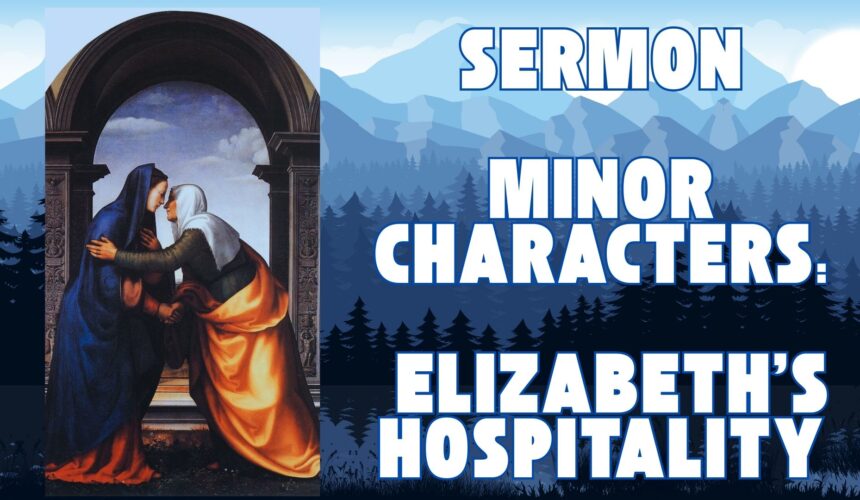December 8, 2024
Luke 1:39 – 45
I grew up in a small Methodist church, and I guess my basic Biblical knowledge was about average for a churchgoing kid raised in the 1970s and early 80s. I knew most of the greatest hits, the Bible stories every kid learns in Sunday School: the two creation stories in Genesis, the story of Noah, Abraham and Sarah, Moses and the Exodus, the birth of Jesus, stuff like that. But it wasn’t until years later that I began to realize a lot of these stories have a distinctive way of being told. There’s a style to Biblical storytelling.
For example, Biblical stories often purposely leave things out. In the Book of First Samuel, Israel’s first King, Saul, is described as tall. (In fact, the way the story is told it kind of sounds like that’s his main qualification: he’s tall, so let’s make him King.) We’re told that King David, who eventually takes over the throne from Saul, is good looking. But beyond those few details, there’s no indication of what either David or Saul looked like. There’s nothing at all in the Bible about how Jesus looked, and that’s the same for most prominent characters in scripture. The Bible gives us no idea of what they looked like.
The Bible leaves out other things, too. One of those passages I learned growing up was the story from Genesis 22, of how God tested Abraham by telling him to sacrifice his son Isaac. It’s one of the weirdest tales in all of scripture, and it’s hard for me to imagine what was going through Abraham’s mind as all this is happening. But one reason it’s hard for me to imagine what Abraham was thinking is the Bible says nothing about it. We have no idea what is going on in either Abraham’s or Isaac’s mind as the two of them ride to Mount Moriah, where the sacrifice is supposed to take place. Is Abraham sad or mad or scared? Is he looking for a way out? Is Isaac beginning to get a little nervous? Who knows? Scripture doesn’t say.
Of course, there are also big gaps in the life of Jesus. In the Gospels of Matthew and Luke, we read about his birth. In Matthew, we hear about these foreigners, called “wise men from the east,” who show up and offer him gifts. But in Matthew, that’s all we hear about Jesus until he’s thirty years old. In Luke, we hear about his birth and his parents taking him to the temple to dedicate him. Then we have one short episode twelve years later, when he’s talking with Rabbis in the temple. And then just like Matthew, we don’t see him again until he’s about thirty. And in Mark and John, there’s nothing about his birth or childhood at all.
I think the Bible leaves out these details on purpose. I think when we notice something missing like that, the authors are inviting us to fill in the blanks with our own imagination, our own understanding. We’re invited to wonder, to ask questions. Bible stories are not just handed to us with every detail filled in, tied up with a perfect bow and a clear moral of the story. They’re often ambiguous. We’re supposed to do some work, use our imaginations, ask questions, wrestle with these stories.
There’s a related aspect to Biblical storytelling that I also love. The Bible is a lot of things, but one of them is the story of God’s people – from the original covenant between God and Abraham to becoming slaves in Egypt to escaping slavery and eventually becoming a powerful Kingdom in the Holy Land, then losing that power and becoming the subject of successive Empires, to the emergence of the Christian movement, all building to God’s final triumph in the Revelation to John, the Bible’s final book. And repeatedly, that story hinges on the actions of people we know almost nothing about.
I talked about this a little last week, and I mentioned some examples like the Hebrew midwives Shiphrah and Puah. They’re some of my favorites among these nearly unknown people. They refuse to carry out the Egyptian Emperor’s genocidal orders to kill Hebrew children. These brave, heroic women save the Hebrew people by standing up to the most powerful person in the known world. But their whole story takes up seven sentences. It’s a paragraph. After that, we never hear about them again. But without them, the Biblical story could not have continued.
Or in the Book of Acts, we read about a woman named Lydia, who’s a leader in the early church. Lydia helps the Apostle Paul start a new congregation at Philippi. She offers Paul and his co-worker Timothy a place to stay while they’re planting the church. And two verses later, she’s gone. We never see her again. We know she was important. But her entire story is told in four sentences.
I don’t think this is a coincidence. (I also don’t think it’s a coincidence that these pivotal people we barely see are often women – but that’s a topic for another sermon.) I think the Biblical storytellers are trying to make a point about our own lives. Outside of our immediate circle of friends and family, we’re all minor characters in the life of the world. But at the same time, like Lydia, like Moses’ sister, like any of the nearly unknown people in the Bible, God’s work in the world may depend on us showing up and being faithful. We may never know the part we played. But we don’t need to. We just need to show up. Be faithful. Take on our little four verse assignment. Maybe that’s enough.
So throughout Advent this year, I’m preaching a sermon series called “Minor Characters,” looking at a few of these nearly unknown people in the Christmas story. Last week, I talked about Joseph, the man who discovered that his fiancé Mary was pregnant, and who, after having a powerful dream, decided to marry her anyway and raise the child as his own. Joseph could have chosen to take no part in this. The Gospel of Matthew tells us he originally planned to separate from Mary and go on with his life. He’d even be respected as a kind and righteous person for the way he planned to do it, making no trouble for Mary. Instead, he chooses the messier and harder route of marrying her and raising a child who he knows is not biologically his.
Today, I want to pick up the story as it’s told in the Gospel of Luke. Mary has learned that she’s going to become mysteriously pregnant. Like I said last week, that puts her in a very dangerous position. In the first century Mediterranean world, a woman pregnant outside of marriage brought shame on her family. She could be publicly condemned, thrown out of her household, left to make what living she could be begging on the street; she could even be stoned to death. So maybe it’s not surprising that Luke says Mary went “with haste” from her home town of Nazareth. I think she understands the danger she could be in. I think she feels a need to get out of town.
Now, given the situation that’s probably not a bad idea. But you do get some sense of Mary’s desperation in the way Luke tells the story. Traveling in that time and place was risky. Especially in the hill country, people generally traveled in groups to protect themselves from robbery and violence. And women were not supposed to travel alone, ever; it would have been scandalous and dangerous at the same time. Not only that, but Mary is going to visit her relative Elizabeth. Elizabeth is the wife of a priest. If she found out why Mary was there, she might not take her in. And remember, this is the first century we’re talking about: it’s not like Mary could just call ahead and make sure things were cool before she headed over. She just had to go and take her chances.
But not only does Elizabeth let her younger relative in, she welcomes Mary with open arms and a beautiful blessing: “blessed is she who believed there would be a fulfillment of what was spoken to her by the Lord.” Elizabeth does not give in to society’s perception of a young unwed mother, traveling scandalously by herself. Instead, she proclaims how blessed Mary is because Mary has decided to trust God.
Last week, I said I admire Joseph because rather than doing the socially acceptable thing of calling off the engagement, he does what God calls him to do. He takes the risk of disapproval and mockery, and raises Jesus as his own.
I think Elizabeth is faced with a similar choice. She can accept society’s judgement about her younger kinswoman. Or she can choose to believe the utterly preposterous truth the Spirit is telling her: that Mary, this unwed, pregnant, peasant woman, is blessed among women; that the child in her womb will change the world. And faced with that choice, Elizabeth chooses to believe that Mary is who God says she is.
Now, in one way, we’ll probably never be in Elizabeth’s position. We’re probably never going to be asked to accept that a relative of ours is pregnant with the Messiah. But you could say we always find ourselves in Elizabeth’s position. We’re always asked to choose between believing that someone is who we’re told they are; or maybe who they’ve been told they are; or seeing them truthfully instead, seeing them for who God says they are.
Some of you probably know the work of Father Greg Boyle. Fr. Boyle is a priest who years ago began work in a desperately poor and violent area of Los Angeles called Boyle Heights, where gang activity was rampant. Over the years, he’s built an organization called Homeboy Industries, which is the largest gang intervention program in the world. A few years back, he spoke at St. Andrew United Methodist Church while I was serving there, and he told this story.
Boyle said he’d been invited to attend a large conference, and was asked to bring a couple of former gang members with him, so they could talk about their experiences. And after the presentation, there was a question and answer period. The first question came from a woman who addressed one of the former gang members, whose name was Mario. She said, “you told us you have children now. What advice do you give them?” Boyle said Mario was silent for a long time. And then, his voice shaking with emotion, he said, “I just don’t want my kids to turn out like me.”
Boyle said the woman who asked the question started to cry. And she said, “why wouldn’t you want your kids to turn out like you? You are loving and gentle and wise. I hope your kids turn out to be like you.” In that moment, it seems to me, she saw past who much of society said Mario was. She saw past who Mario feared he was. She saw who God said he was. And Boyle said the entire audience stood and applauded while Mario covered his face in his hands and wept.
Who knows? Maybe in that moment, the woman asking the question helped Mario see himself in a new way. And maybe in his answer, he helped her see a kind of gentle, life-affirming power in herself. It’s not easy to cultivate that kind of seeing. If we try to see people as God sees them, we’ll probably be mocked for it. We’ll be told it’s unrealistic, that people will take advantage of us. But maybe there’s nothing more realistic. Maybe seeing people as God sees them is the most realistic way possible. Maybe the person standing in front of us is like Mary to Elizabeth: the one who bears the Christ to us. And maybe our two sentences, the blessing we offer, the faith we keep, our four or five verses of the story, maybe they can change everything.


